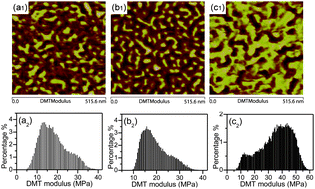Phase behavior and nanomechanical mapping of block ionomer complexes
Abstract
Block ionomer complexes SSEBS-c-PCL were prepared, as a consequence of

* Corresponding authors
a
Polymers Research Group, Institute for Frontier Materials, Deakin University, Locked Bag 2000, Geelong, Victoria 3220, Australia
E-mail:
qguo@deakin.edu.au
b NewSpec Pty. Ltd., 134 Gilbert Street, Adelaide, South Australia 5000, Australia
c Centre for Advanced Materials Technology (CAMT), School of Aerospace, Mechanical and Mechatronic Engineering J07, The University of Sydney, Sydney, New South Wales 2006, Australia
Block ionomer complexes SSEBS-c-PCL were prepared, as a consequence of

 Please wait while we load your content...
Something went wrong. Try again?
Please wait while we load your content...
Something went wrong. Try again?
S. Wu, Q. Guo, T. Zhang and Y. Mai, Soft Matter, 2013, 9, 2662 DOI: 10.1039/C2SM27512K
To request permission to reproduce material from this article, please go to the Copyright Clearance Center request page.
If you are an author contributing to an RSC publication, you do not need to request permission provided correct acknowledgement is given.
If you are the author of this article, you do not need to request permission to reproduce figures and diagrams provided correct acknowledgement is given. If you want to reproduce the whole article in a third-party publication (excluding your thesis/dissertation for which permission is not required) please go to the Copyright Clearance Center request page.
Read more about how to correctly acknowledge RSC content.
 Fetching data from CrossRef.
Fetching data from CrossRef.
This may take some time to load.
Loading related content
